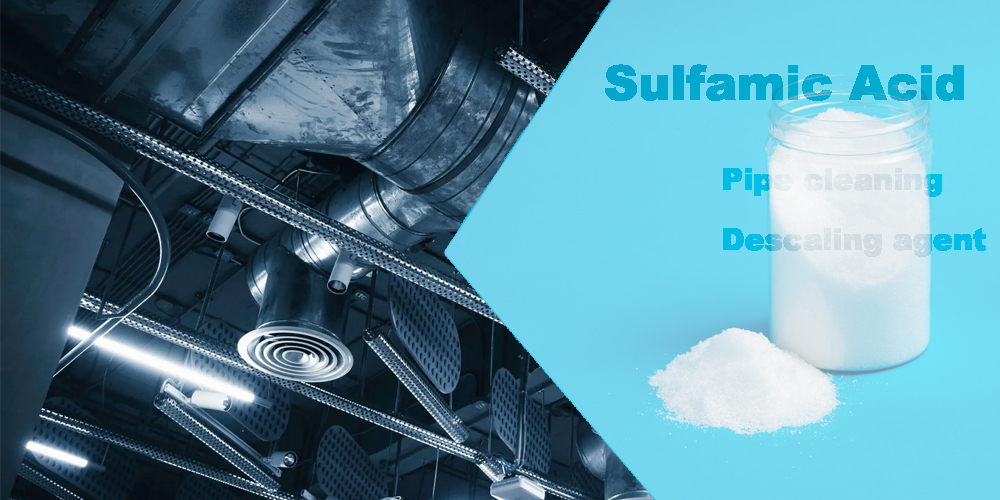
Sulfamic Acad, o se malosi o le tino, ua faʻaaogaina lautele, ua faʻaaogaina lautele i le fanua o Alamanuia Faʻamamaina ona o le tulaga lelei o le mea leaga ma le puipuiga o le siosiomaga. Paipi o se vaega taua o le pisinisi o aso nei ma le ola. O lona faʻamamaina ma lona faʻatumauina o le a aʻafia ai tuʻusaʻo ai le gaosiga o le lelei. O lenei tala o le a talanoaina le aoga aoga ma le puipuiga oSulfamic acid i le paipa faamamaina.
O le a le aoga o le sulfamic?
Sulfamic acid o se lanu gaoa po o paʻepaʻe proten ma le lelei o le mataua ma le mautu. O se vailaʻau oona vailaʻau o loʻo aofia ai le Anono Group (-nh2) ma Sulfonic Acad Group (-SO3h). E masani ona faʻaaogaina o se vai togafitiga, faʻamamaina ma le vailaʻau. I le avea ai o se vailaʻau acidic, sulfamic acid mafai ona soloia uamea povi povi, kamu, eleʻele ma fua, o lea, o lea, o lea, o lea e tele tulaga i pipeline faamama.
Uiga ma lelei o le sulfamic acid
O le mafuaaga o le mafuaʻaga o le sulfamic acid e mafai ona avea ma se sili ona lelei paipa faʻamama le sooupu e le mafai ona vavaeese mai i ona meatotino tulaga ese.
Malosi le aciday: Sulfamic acidE malosi le amio ma mafai ona faʻauia lelei le tele o masima e tele, oxides ma okeni ma le okeni o loʻo faʻapipiʻi i totonu o le paipa. E matua lelei lava i le faʻateʻaina o kalisiu ma magnesium i le masima masima, ma e lelei mo le faʻavaeina o le pa o totonu o le paipa o le paipa. E manino le faʻamamaina o aʻafiaga i le fua o faʻafitauli. Faʻatusatusa i faiga faʻaleaganuʻu e pei o Hydrochloric Avid e le gata i le maualuga o le faʻamamaina poʻo ni mea leaga ma masini.
Maualalo le leaga:Faatusatusa ma le aga masani i Inteoganic malosi, sulfamic acid e itiiti ifo i totonu o le uamea paipa (bepleass wapemis wipes, turc. E maualuga le saogalemu pe a fufulu paipa o mea eseese. O lenei faiga e faʻapitoa ai mo pisinisi ma mea maualuluga i paipa o mea faigaluega, pei o le gaosiga o taumafa, vailaʻau, faasitepu ma isi alamanuia.
Maualuga le leleiSulfamic Acid ma o le masima e mafai ona fausia faigata faigata ma le tele o uʻamea uʻamea, o loʻo maua ai ni tulaga lelei i le aveeseina o uʻamea povi ma fua.
Faigofie ona galue ma pulea:A faʻaaoga Slolumic Acad mo Paipeline Mama, ua masani lava ona manaʻomia se tapenaga faigofie o le faʻamamaina o le fofo ma fufulu e tusa ai ma le vevela. Faʻatusatusa i le faʻatamala o fesoʻotaʻiga auala o le faʻamamaina o auala, o vailaʻau mama e sili atu le faigofie ma sefe le tele o le faʻafitauli ma le taimi. O le faʻaaogaina o le faʻagasologa o Sulfimic Acid e matua faigofie ma mafai ona galulue i lalo o le vevela, faia o le paipa faʻamama sili atu mautu mautu gaioiga.
Talosaga o Sulfimic Acad i Paipaline Fusia
Sulfamic Acad ei ai le lautele o talosaga i paipa o loʻo faʻamamaina, tele aofia ai mea nei:
Boilers ma vevela fesuiaiga meafaigaluega:E mafai ona aveese e le sulfamic acing le tele o oloa ma le 'aisa oloa i totonu o tagata faipisinisi, o le puipuia o le vevela, faʻaleleia le vevela o le masini.
PASATION PINILING:I le taimi o faʻagaioiga o gaosiga o vailaʻau lea, o laufanua laufanua o paipa e manino lava i le faʻamaligiina ma le leaga. Sulfamic Acad mafai ona aveese nei palapala ma mautinoa le paopau lelei ma masani masani o meafaigaluega.
Meafaigaluega gaosi oloa:O mea gaosi gaosi oloa e iai le maualuga maualuga o le hygiene manaoga. Sulfimic Acad e mafai ona ave lelei le porotini, gaʻo ma isi mataupu o loʻo i totonu o meafaigaluega ina ia mautinoa le saogalemu ma le tumama o meaʻai.
Pepa pepa:I le taimi o le pepa faʻapipiʻi, fafie fafie fiber, faʻapipiʻi ma isi mea e faʻaputu i totonu o le pa o le paipa o le paipa. Sulfamic acid mafai ona aveese nei palapala ma faʻaleleia le lelei o le pa puipui.
Mea e te matauina pe a fufulu sulfamic acid paipa
E ui lava o sulfamic acid e le tele o itu lelei ile paipa o loʻo faʻamamaina, o mea nei e tatau ona faʻailoaina i faʻataʻitaʻiga aoga:
Pulea Pulea:O le totoʻa o le sulfamic acid e manaʻomia e filifilia e tusa ma le ituaiga ma le tikeri o le palapala. Afai e maualuga tele le mafaufau loloto, o le a faigofie ona ta piano ai le paipa, ma afai o le mafaufau loloto tele, o le faʻamamaina o le a matitiva.
Vecu puleaga:Ole faʻateleina o le vevela o le faʻamamaina o le a fesoasoani televave le tali atu, ae afai o le vevela e maualuga tele, o le a faigofie ona faʻatonutonuina le vaivaiga, e manaʻomia ona pulea i totonu o le faʻailoga talafeagai (pe a i lalo o le 60 ° i lalo ole 60 ° C).
Taimi o le pule: OuO le taimi faʻamamaina e puʻupuʻu tele, e le mafai ona aveese le perte; Afai e umi le taimi o le faamama, o le a faigofie ona mafua ai le le talafeagai i le paipa.
Puipuiga Puipuiga:Sulfamic acid e paie. Puipuiga puipuia, totigilima ma isi masini puipuia e tatau ona ofuina i le taimi o faʻagaioiga e aloese ai mai le faʻafesoʻotaʻiga.
A o le lelei ma le saogalemu paipa kipela, sulfamic kemisi o loʻo sili atu le taua o tiute i totonu o gaosi oloa. E ala i le filifilia o le faʻatatauina o le faʻamalieina, ma le taimi, ma faʻataʻitaʻiina faiga puipuia, o lelei o supamaka ACIge, e mafai ona faʻaleleia atoatoa, ma o le tautuaina o masini e mafai ona faʻalauteleina.
Taimi taimi: Nov-15-2024
